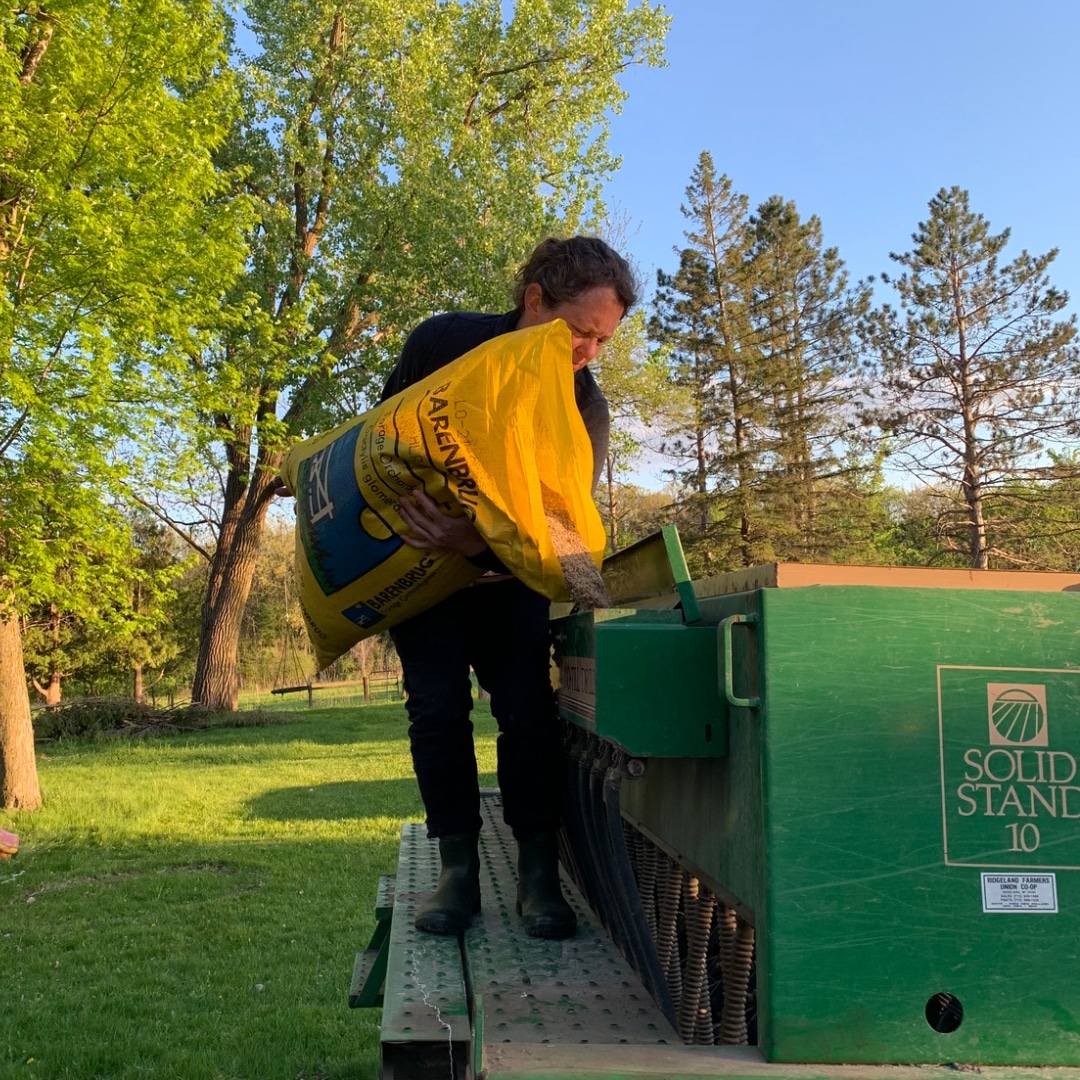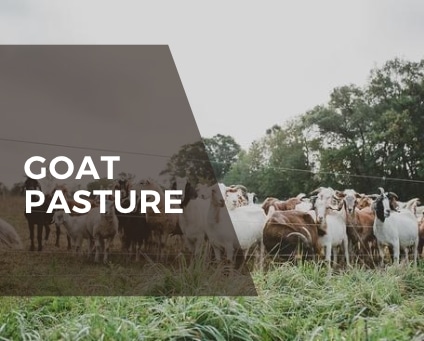Creating the right pasture for your meat goat herd may be easier than you might think. However, it’s important to know the preferred forage and grazing preferences for goats, especially since they tend to differ from other livestock species.
Table of contents
Goat Diet
Very little academic research has been done on the nutritional needs of goats, especially for meat goats. Most of the body of research has been gleaned from similar livestock species, such as cattle and sheep, (National Research Council of the National Academies, 2007).
What we do know about the goat’s diet is they tend to be browsers over grazers, which means they prefer to reach up high to eat, often standing on their hind legs to eat tree leaves or other woody plant species.
Does this mean goats will only eat browse and not traditional pasture? No, they just have a preference for browse, as well as eating in a top-down manner.
According to Undersander (2002), goats prefer 20% forages (grasses, legumes), 20% weeds, and 60% browse for their diet. This is actually more similar to the dietary preferences of white-tail deer, as compared to cattle or sheep.

What to feed goats?
Quality pasture or forage, such as hay, can serve as the main feed source for a goat herd. They’ll also need regular access to water and a loose, complete goat mineral.
Forage, also categorized as roughage feed, includes grasses and forbes, with the exception of woody species, and also hay. Forage can be enough to feed goats, depending on their life stage and point in production cycle (young/growing kids, pregnancy stage, lactation, or maintenance).
Depending on the quality of the pasture during the year and the production cycle of your goat herd, supplemental feeding may be needed, such as feeding hay, as a dry roughage feed source, grain as a concentrated feed, or a combined approach.
To get the best use of your grazing pastures for goat feed, you’ll want to time the feeding of your highest nutritional needs when the pasture is at its peak for high quality forage. This typically is in the spring when plants are in a vegetative stage. You’ll need to determine the approximate timing based on when spring usually “arrives” in your region.
For example on our farm in Wisconsin, we kid in late spring so we can take advantage of the high forage quality in the spring when our does lactating (with kids nursing) when they need the best nutrition available.
Other goat-feeding resources
- Specific diet needs of meat goats can be read here from the University of Arkansas
- How to evaluate body conditioning scores here from Langston University

Establishing your Goat Pasture
Pastures for goats can include a mix of plant species including grasses, legumes, forbes, and even woody browse. Before you find the best goat pasture seed mix for your herd, you’ll need to evaluate the context of your farm.
There isn’t a one-size-fits-all goat pasture seed mix. If you find one, it may not necessarily work for your farm since no farm is alike when it comes to factors such as climate and soil type. So what do you need to take into consideration when creating your goat pasture?
First, you’ll need to think about the context of your farm:
- Soil type
- Pasture growing season, dormant seasons
- Soil quality and needs
- Rainfall
- Climate, weather
You can learn about your specific soil type needs and suggested pasture species by using the USDA Soil Survey tool. Learn about how to the free online tool here with a video walk through. It is a tremendous tool that so many farmers and ranchers don’t know exist.
A diverse pasture mix has advantages over a single or dual-species pasture mix since it tends to be more resilient to changes in weather, such as a drought. A variety of plant species also means more forage availability throughout the growing season since each species has its own growth rate and timing, such as what you might see with cool-season grass or warm-season species.
How much grass can a goat eat in a day?
Goats tend to graze about six hours a day on average. Their daily forage needs are about 5 lbs. of dry matter for a does with two kids.
Source: Undersander D., et. al. (2022). Pastures for profit: A guide for rotational grazing. University of Wisconsin-Extension.
Goat Pasture Seed Mix
The context of your farm will help you determine your pasture seed mix. Here are a few recommendations to take into consideration on building your mix:
- Look at what works in your local environment and climate. It also can be helpful to look at what native plant species were common in your region 100-150 years ago. This will give you more background on plant species that might have more success on your farm.
- Use the USDA Forage Suitability Groups based on the NRCS soil maps through the web soil survey. This online tool will allow you to access a list of forages that should work well in your climate and soil type. From here you can use this list as a starting point to see what forage species may work well for goats.
- Consider anti-parasitic species. These plants, such as chicory and birdsfoot trefoil, have natural tannins, which can help with managing parasite issues with small ruminants.
- Keep in mind pasture diversity, as noted earlier.

Goat forage seed mix we use on our farm
On our farm, Cylon Rolling Acres in Western Wisconsin, I’ve taken the approach listed in the section above on how I’ve created by goat pasture seed mix. Additionally, I’ve observed our goats tend to graze legumes over grasses, so I’ve intentionally focused on a grass-legume mix. I also have looked at whitetail deer food plot mixes as ideas for forage seed mix options and inspiration.
Over the years our current goat pasture has been interseeded into an existing prairie stand, which includes a diverse pasture mix:
- Clovers: white, red, sweet
- Alfalfa
- Chicory
- Plantain
- Birdsfoot trefoil
- Tall fescue
- Meadow fescue
- Italian ryegrass
- Perennial ryegrass
- Alaskan brome
- Meadow brome
- Timothy
- Festulolium
- Orchard grass
We purchased a pasture mix designed for grazing livestock and added in other forage species, such as alfalfa, clovers, birdsfoot trefoil, chicory, and plantain. Native species have started to establish on their own since we planted the seed mix in different ways over the years including interseeding, hand broadcasting, and using a no-till drill. Additionally, with each rotation of grazing paddocks in our pastures, along with adequate rest for regrowth, the quality of our pastures has improved.
Learn more about my approach in the video below on how we’re building forage species in our goat pastures and working towards getting the desired forage we want for our goats.
Goat Pasture FAQ
Yes, goats can eat grass. Goats dietary preference tends to follow this breakdown: 20% forages (grasses, legumes), 20% weeds, and 60% browse (leaves and bark from woody plants). However, goats can still graze traditional pastures with forages, including grasses and legumes.
Yes, goats can eat clover. On our farm we have quite a bit of clover in our pastures since it’s high quality source of feed. We have sweet, white and red clover.
In the spring time when there’s new pasture growth, you should watch for any signs of bloat if goats eat too much legumes. We offer free-choice sodium bicarbonate (baking soda) alongside our mineral mix to serve as a rumen buffer aid. Additionally, we also make sure we slowly transition our herd out to pasture in the spring to avoid any bloat issues. Clover can be also less of an issue when it’s part of a diverse pasture mix, vs a solid stand.
Yes, goats can eat alfalfa. Alfalfa is one of our primary forage species we have incorporated into our pastures, and in our hayfields. It is a very high quality forage, which is a great feed source for your goat herd, especially during times when their nutrition demands are high, such as late gestation and lactation.
Just like clovers, caution should be taken when grazing alfalfa especially in the spring and watch for signs of bloat. Our goats have access to sodium bicarbonate in their mineral feeder (baking soda) so they can use it as needed to buffer their rumen. We also make sure we transition our goats and sheep slowly from hay to fresh pasture in the spring to avoid issues. Alfalfa can be less of an issue when it’s part of a diverse pasture as compared to a solid stand of alfalfa only.
Most of the time goats do not need grain. However, it truly depends on your feed quality (pasture, hay or grain), and purpose or stage in life of your goats. Certain breeds or genetic lines may do well without grain.
Goats who are late in their gestation, lactating or are young, growing kids demand a higher level of nutrition, as compared to open does or bucks out of breeding season. If your forage (pasture or hay) is of good quality, supplementing with grain may not be needed. On our farm we are raising our meat goats without grain, using our pasture and high quality hay when it is winter.
Dairy goats may need additional supplements to maintain their lactation, which often includes grain.

LEAVE A COMMENT
Comments